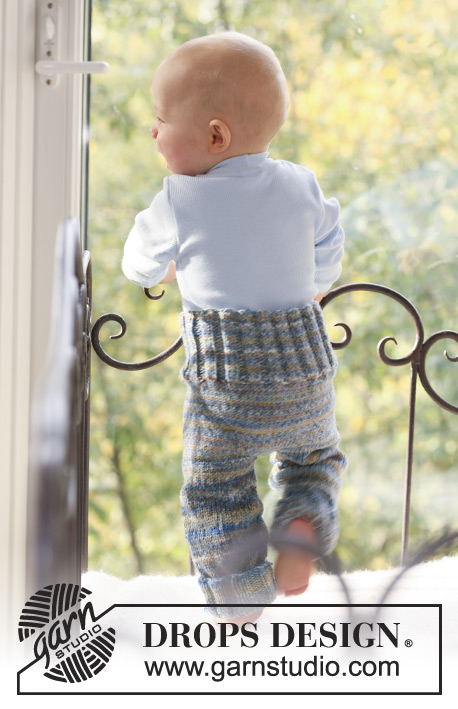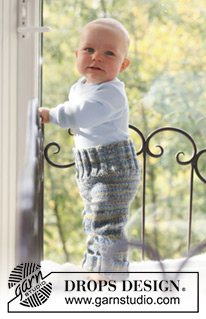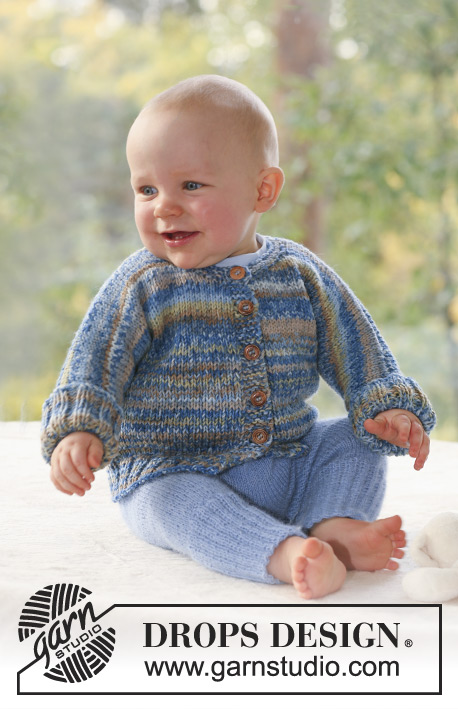Comments / Questions (29)
![]() Elisabeth Schilling wrote:
Elisabeth Schilling wrote:
Le nom pour BabyDrops 18-19 ma proposition ISAAC
07.10.2015 - 17:02
![]() Constanza wrote:
Constanza wrote:
Hola. Tengo una pregunta a cerca de los aumentos en la indicación PANTALÓN. Dice q los aumentos se realizan a cada dos vueltas. ¿Esto significa que entre cada vuelta con aumento se deben tejer dos vueltas sin aumento o sólo una? Gracias!
13.08.2015 - 05:27DROPS Design answered:
Hola Constanza. Los aumentos se trabajan de la sig manera: 1 vta con aum, otra vta sin aum.
13.08.2015 - 12:08
![]() Inger Johanne wrote:
Inger Johanne wrote:
2 tråder Fabel 19 m x 25 p, då sakl det strikkast med dobbelt garn ?
27.05.2015 - 12:25DROPS Design answered:
Hej Inger, Ja det stemmer, bukserne strikkes med dobbelt garn. God fornøjelse!
27.05.2015 - 12:28Rachel wrote:
Should the increases before splitting off the legs be on the front and the back or just the front as implied in the pattern? It doesn't make much sense to me to have them only on one side! I'd really love to know before I go any further please!
16.08.2014 - 01:11DROPS Design answered:
Dear Rachel, inc are done on mid front, each side of marker, ie 2 sts are inc on mid front. Happy knitting!
18.08.2014 - 12:39
![]() Sabine wrote:
Sabine wrote:
Hallo, ist es jetzt richtig, dass der Zwickel nur VORNE gestrickt wird? Auf dem Foto sieht es so aus als ob auch hinten Zunahmen sind...ich bitte um Antwort damit ich weitermachen kann :-) Danke!
12.05.2014 - 10:07DROPS Design answered:
Liebe Sabine, ja, die Zunahmen werden nur vorne gestrickt. Weiterhin gutes Gelingen!
12.05.2014 - 14:56
![]() Theresa wrote:
Theresa wrote:
Hej Jeg er ved at strikke i str 18 mdr men forstår ikke nedenstående... Nu tages der 1 m ud på hver side af 4 m midt foran (2 m på hver side af mærket). Skal det kun være midt foran eller også midt bagpå????Forstår jeg det forkert...synes nemlig slet ikke at det virker logisk. Mvh Theresa
09.04.2013 - 21:50DROPS Design answered:
Du tager 1 m ud på hver side af de 4 masker foran, det bliver da 2 nye m 8 gange = ialt 16 nye masker foran.
10.04.2013 - 12:12
![]() June wrote:
June wrote:
Nå økes det 1 m på hver side av 4 m midt foran (2 m på hver side av merket) – SE ØKETIPS. Gjenta økningen på hver 2.omg totalt 8-9-9 (10-11) ganger = 108-114-118 (124-130) m. Skal man øke 4 masker per 2. runde? Jeg strikker til den minste str og vil da ha 92 +32 masker. Får ikke dette til å stemme med de 108 maskene jeg skal ha før jeg begynner på beina
23.03.2013 - 11:36DROPS Design answered:
Kaere June. Du skal öke 1 m paa hver side af merket midt foran = 2 m per gang. Du öker totalt 8 ganger = 16 m. Saa ender du paa 108 maskene. God fornöjelse videre.
28.03.2013 - 13:59
![]() Iris wrote:
Iris wrote:
Hallo Conny! Danke für deine Antwort vorne und hinten wär mir ja logisch so wie du es machst - aber die Anleitung besagt zunamen nur VORNE!
06.02.2013 - 19:37
![]() Iris wrote:
Iris wrote:
Ich habe eine Frage zur Zwickelzunahme - in der Anleitung steht auf beiden Seiten der mittleren 4 Maschen VORNE zunehmen... Wir ein verbreiternder Zwickel nicht normalerweise auf der Hinterseite (Po-Seite) gearbeitet bzw. auf Vorder und Hinterer Mitte?
06.02.2013 - 13:03Conny answered:
Hallo iris,ich hab solche höschen schon öfter gestrickt und komme mit den zunahmen vor und nach den markierungsfäden ( vorn und hinten)in jeder 2.runde, bestens klar.viel erfolg. LG conny
06.02.2013 - 15:57Serene Mark wrote:
Hi there just wanted to say that the wrong increase video has been featured for this pattern, babydrops 18-19 should not be an M1. Should have been using loop under.
24.10.2012 - 04:38
Fun with Pants#funwithpants |
|
 |
 |
Knitted pants for baby and children in 2 threads DROPS Fabel
DROPS Baby 18-19 |
|
|
INCREASING TIP: Inc 1 st by picking up st from previous row and K this. DECREASING TIP: Dec as follows before marker: K2 tog. Dec as follows after marker: Slip 1 st as if to K, K1, psso. ---------------------------------------------------------- ---------------------------------------------------------- PANTS: Worked in the round on circular needle from waist down. Cast on 114-120-120 (126-132) sts on circular needle 3.5 mm [US 4] with 2 threads Fabel. Work 8-9-9 (10-10) cm [3⅛"-3½"-3½" (4"-4")] rib, K3/P3. Change to needle size 4 mm [US 6] and K 1 round, AT THE SAME TIME dec 22-24-20 (22-24) sts evenly on round = 92-96-100 (104-108) sts. Insert 1 marker mid front and 1 marker mid back (= 46-48-50 (52-54) sts between markers). Continue in stockinette st until piece measures 12-14-15 (15½-16) cm [4¾"-5½"-6" (6⅛"-6¼")]. Now inc 1 st on both sides of the middle 4 sts at front (marker sits in the middle of these 4 sts) – SEE INCREASING TIP. Repeat the inc on every other round a total of 8-9-9 (10-11) times = 108-114-118 (124-130) sts. When all inc are complete piece measures approx 18-21-22 (23-24) cm [7"-8 ¼"-8¾" (9"-9½")]. On next round bind off 6 sts mid front and mid back (= 3 sts on each side of markers) = 48-51-53 (56-59) sts left for each leg. LEG: Slip sts for on leg on a stitch holder and slip sts for the other leg on double pointed needles size 4 mm [US 6] = 48-51-53 (56-59) sts. Continue in stockinette st in the round – insert a marker on the inside of leg. AT THE SAME TIME when leg measures 4-4-4 (5-6) cm [1½"-1½"-1½" (2"-2⅜")] dec 1 st on both sides of marker – SEE DECREASING TIP. Repeat the dec on every 2-3-4 (5-6) cm [3/4"-1⅛"-1½" (2"-2⅜")] a total of 4 times = 40-43-45 (48-51) sts. When leg measures 12-15-18 (23-28) cm [4 ¾"-6"-7" (9"-11")] change to double pointed needles size 3.5 mm [US 4], K 1 round, AT THE SAME TIME inc 8-5-9 (6-9) sts evenly = 48-48-54 (54-60) sts. Continue in rib, K3/P3. Bind off when rib measures 10 cm [4"]. Pants measures 40-46-50 (56-62) cm [15 ¾"-18"-19 ¾" (22"-24⅜")] from waist to bottom of leg. Slip sts from stitch holder back on double pointed needles size 4 mm [US 6] and work like the other leg. ASSEMBLY: Sew opening between legs. Fold rib at bottom of legs if needed. |
|

|
|
Have you finished this pattern?Tag your pictures with #dropspattern #funwithpants or submit them to the #dropsfan gallery. Do you need help with this pattern?You'll find 10 tutorial videos, a Comments/Questions area and more by visiting the pattern on garnstudio.com. © 1982-2025 DROPS Design A/S. We reserve all rights. This document, including all its sub-sections, has copyrights. Read more about what you can do with our patterns at the bottom of each pattern on our site. |
|

















































Post a comment to pattern DROPS Baby 18-19
We would love to hear what you have to say about this pattern!
If you want to leave a question, please make sure you select the correct category in the form below, to speed up the answering process. Required fields are marked *.